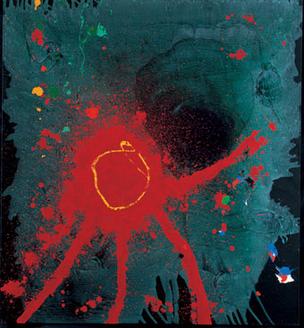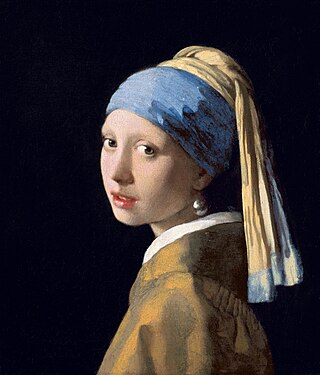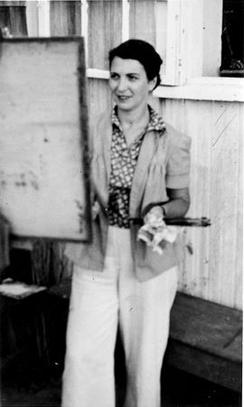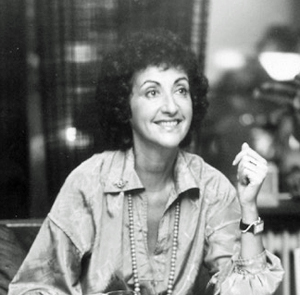Related Research Articles
Abstract expressionism was first used in Germany in 1919 in the magazine Der Sturm, regarding German Expressionism. Alfred Barr was the first to use this term in 1929 for works by Wassily Kandinsky.

Visual art of the United States or American art is visual art made in the United States or by U.S. artists. Before colonization, there were many flourishing traditions of Native American art, and where the Spanish colonized Spanish Colonial architecture and the accompanying styles in other media were quickly in place. Early colonial art on the East Coast initially relied on artists from Europe, with John White the earliest example. In the late 18th and early 19th centuries, artists primarily painted portraits, and some landscapes in a style based mainly on English painting. Furniture-makers imitating English styles and similar craftsmen were also established in the major cities, but in the English colonies, locally made pottery remained resolutely utilitarian until the 19th century, with fancy products imported.

Helen Frankenthaler was an American abstract expressionist painter. She was a major contributor to the history of postwar American painting. Having exhibited her work for over six decades, she spanned several generations of abstract painters while continuing to produce vital and ever-changing new work. Frankenthaler began exhibiting her large-scale abstract expressionist paintings in contemporary museums and galleries in the early 1950s. She was included in the 1964 Post-Painterly Abstraction exhibition curated by Clement Greenberg that introduced a newer generation of abstract painting that came to be known as color field. Born in Manhattan, she was influenced by Greenberg, Hans Hofmann, and Jackson Pollock's paintings. Her work has been the subject of several retrospective exhibitions, including a 1989 retrospective at the Museum of Modern Art in New York City, and been exhibited worldwide since the 1950s. In 2001, she was awarded the National Medal of Arts.
Action painting, sometimes called "gestural abstraction", is a style of painting in which paint is spontaneously dribbled, splashed or smeared onto the canvas, rather than being carefully applied. The resulting work often emphasizes the physical act of painting itself as an essential aspect of the finished work or concern of its artist.

Monochromatic painting has played a significant role in modern and contemporary Western visual art, originating with the early 20th-century European avant-gardes. Artists have explored the non-representational potential of a single color, investigating shifts in value, diversity of texture, and formal nuances as a means of emotional expression, visual investigation into the inherent properties of painting, as well as a starting point for conceptual works. Ranging from geometric abstraction in a variety of mediums to non-representational gestural painting, monochromatic works continue to be an important influence in contemporary art.
The New York School was an informal group of American poets, painters, dancers, and musicians active in the 1950s and 1960s in New York City. They often drew inspiration from surrealism and the contemporary avant-garde art movements, in particular action painting, abstract expressionism, jazz, improvisational theater, experimental music, and the interaction of friends in the New York City art world's vanguard circle.

Jack Tworkov was an American abstract expressionist painter.

Color field painting is a style of abstract painting that emerged in New York City during the 1940s and 1950s. It was inspired by European modernism and closely related to abstract expressionism, while many of its notable early proponents were among the pioneering abstract expressionists. Color field is characterized primarily by large fields of flat, solid color spread across or stained into the canvas creating areas of unbroken surface and a flat picture plane. The movement places less emphasis on gesture, brushstrokes and action in favor of an overall consistency of form and process. In color field painting "color is freed from objective context and becomes the subject in itself."

Hans Hofmann was a German-born American painter, renowned as both an artist and teacher. His career spanned two generations and two continents, and is considered to have both preceded and influenced Abstract Expressionism. Born and educated near Munich, he was active in the early twentieth-century European avant-garde and brought a deep understanding and synthesis of Symbolism, Neo-impressionism, Fauvism, and Cubism when he emigrated to the United States in 1932. Hofmann's painting is characterized by its rigorous concern with pictorial structure and unity, spatial illusionism, and use of bold color for expressive means. The influential critic Clement Greenberg considered Hofmann's first New York solo show at Peggy Guggenheim’s Art of This Century in 1944 as a breakthrough in painterly versus geometric abstraction that heralded abstract expressionism. In the decade that followed, Hofmann's recognition grew through numerous exhibitions, notably at the Kootz Gallery, culminating in major retrospectives at the Whitney Museum of American Art (1957) and Museum of Modern Art (1963), which traveled to venues throughout the United States, South America, and Europe. His works are in the permanent collections of major museums around the world, including the Metropolitan Museum of Art, Tate Modern, Germanisches Nationalmuseum, National Gallery of Art, and Art Institute of Chicago.
Al Held was an American Abstract expressionist painter. He was particularly well known for his large scale Hard-edge paintings. As an artist, multiple stylistic changes occurred throughout his career, however, none of these occurred at the same time as any popular emerging style or acted against a particular art form. In the 1950s his style reflected the abstract expressionist tone and then transitioned to a geometric style in the 1960s. During the 1980s, there was a shift into painting that emphasized bright geometric space that's deepness reflected infinity. From 1963 to 1980 he was a professor of art at Yale University.

Lyrical abstraction is either of two related but distinct trends in Post-war Modernist painting:
Friedel Dzubas was a German-born American abstract painter.

Theodoros Stamos was a Greek-American painter. He is one of the youngest painters of the original group of abstract expressionist painters, which included Jackson Pollock, Willem de Kooning and Mark Rothko. His later years were negatively affected by his involvement with the Rothko case.

The history of Western painting represents a continuous, though disrupted, tradition from antiquity until the present time. Until the mid-19th century it was primarily concerned with representational and Classical modes of production, after which time more modern, abstract and conceptual forms gained favor.
Michael Goldberg was an American abstract expressionist painter and teacher known for his gestural action paintings, abstractions and still-life paintings. A retrospective show, "Abstraction Over Time: The Paintings of Michael Goldberg", was shown at MOCA Jacksonville in Florida from 9/21/13 to 1/5/14. His work was seen in September 2007 in a solo exhibition at Knoedler & Company in New York City, as well as several exhibitions at Manny Silverman Gallery in Los Angeles. Additionally, a survey of Goldberg's work is exhibited at the University Art Museum at California State University, Long Beach since September 2010.

20th-century Western painting begins with the heritage of late-19th-century painters Vincent van Gogh, Paul Cézanne, Paul Gauguin, Georges Seurat, Henri de Toulouse-Lautrec, and others who were essential for the development of modern art. At the beginning of the 20th century, Henri Matisse and several other young artists including the pre-cubist Georges Braque, André Derain, Raoul Dufy and Maurice de Vlaminck, revolutionized the Paris art world with "wild", multi-colored, expressive landscapes and figure paintings that the critics called Fauvism. Matisse's second version of The Dance signified a key point in his career and in the development of modern painting. It reflected Matisse's incipient fascination with primitive art: the intense warm color of the figures against the cool blue-green background and the rhythmical succession of the dancing nudes convey the feelings of emotional liberation and hedonism.

Perle Fine (1905–1988) was an American Abstract expressionist painter. Fine's work was most known by its combination of fluid and brushy rendering of the materials and the use of biomorphic forms encased and intertwined with irregular geometric shapes.
Post-painterly abstraction is a term created by art critic Clement Greenberg as the title for an exhibit he curated for the Los Angeles County Museum of Art in 1964, which subsequently travelled to the Walker Art Center and the Art Gallery of Toronto.
Samuel M. Kootz was a New York City art dealer and author whose Kootz Gallery was one of the first to champion Abstract Expressionist Art.

Lilly Fenichel (1927–2016), was an American painter who explored abstraction through a wide range of media and approaches, with her various periods linked together by a common emphasis on color harmonies and expressive, often calligraphic gesture. Her earliest work is associated with second-generation Bay Area Abstract Expressionism.
References
- ↑ "Ray Parker". 16 January 2018.
- ↑ Post-Painterly Abstraction artist bios retrieved online July 21, 2008
- ↑ Greenberg essay, retrieved online July 21, 2008
- ↑ "Empire State Plaza Art Collection" . Retrieved 21 November 2018.